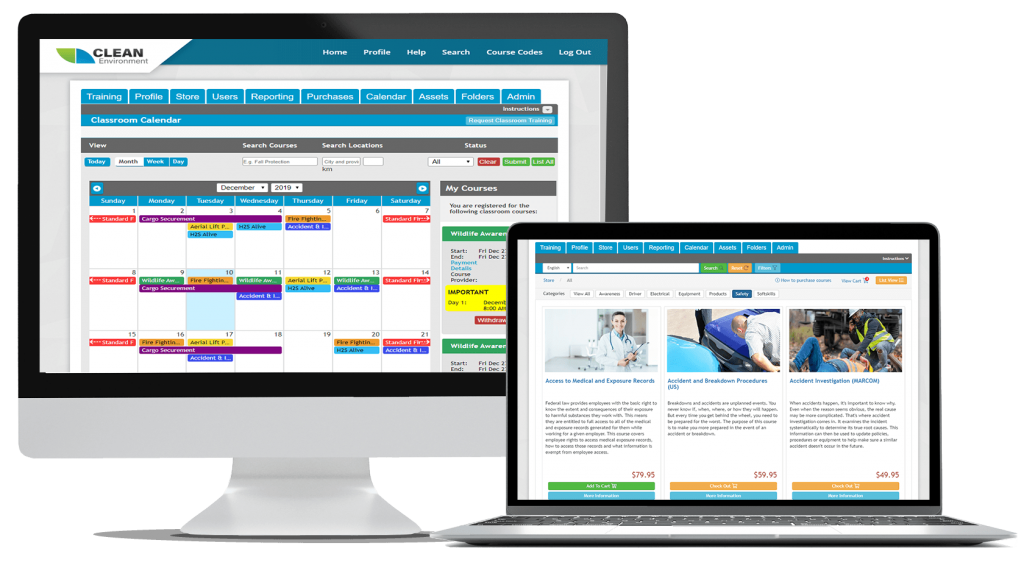
5 Great Advantages of Online Safety Training
Online safety training has a large variety of benefits for companies. Employees are able to pick their schedule individually meaning there is no need to coordinate a group for classroom training. Companies avoid interruptions to their normal duties and activities since employees don’t have to take a course simultaneously. E-learning is also a prevention measure against COVID-19, while group training in a classroom may expose employees.
In the US, the Occupational Safety and Health Administration (OSHA) has mandatory training requirements for employers. Online learning is accepted in many cases, and it provides a simple way for companies to meet OSHA regulations.
- In general, online learning is accepted as a replacement for classroom courses, while practical training must be provided in-person.
- For example, equipment operators must practice under the supervision of a qualified instructor before handling heavy machinery in projects.
Internet has become necessary for doing business, and the use of video conferencing software is on the rise. Thanks to these tools, online safety training has become a viable option for companies. Let’s outline five of the best reasons why you should transition from in-person to online training.
1) Employees Can Work Around Their Schedule
Even if there is a schedule where all participants are available for classroom training, it may not be the most suitable for everyone. For example, an operator could have been driving a truck for several hours right before the course, and fatigue may affect concentration. Retention is very important when dealing with safety training, since the knowledge gained helps workers prevent accidents.
With online safety training, participants can pick hours when they can concentrate on learning. This flexibility improves motivation and retention, since employees are not forced to follow a specific schedule. Learning is not limited to schedules in which some employees may be feeling tired or distracted, which can often be the case with classroom training.
2) Employees Are More Engaged
Online learning can also be enhanced with features that make participants more interested. Gamification has become very popular, and courses are often divided into levels with scores and achievements. These features challenge employees to learn as much as possible, while providing them with a way to monitor progress. Classroom evaluations may cause anxiety, and participants cannot choose when to take them.
Employees receive private feedback in an online classroom, and they can review previous content as needed. This flexibility is not possible with group training, since the course is delayed for everyone when repeating topics. Employees may avoid asking questions for this reason.
3) Improves Employee Learning Retention

Online training uses time more productively since it can focus on information and skills that are relevant for each participant. Courses become more interesting when employees can see a direct relationship between the content and their job. Thanks to this flexibility, e-learning can be customized for the specific needs of a job position or skilled trade.
Classroom courses are less effective for customized training since they are often taken by groups of employees. Even when participants work in the same department in a company, their learning needs can be very different.
4) Gives Employees Control Over Their Learning
One of the main limitations of classroom training is having to find a suitable schedule for all participants. This can be especially difficult in a large organization that operates across several cities and timezones. A company that only uses in-person training must repeat the course for each city, and possibly with several schedules per location.
E-learning gives employees the freedom to choose when to take a course. They can pick hours where the course will not interfere with work, and when they can concentrate better. An online learning experience can be customized more easily since each employee can be provided with useful and relevant content.
5) Caters to Employee Learning Styles
Everyone has a learning style, and traditional courses often provide information in a way that is not suitable for all participants. For example, one instructor may focus on slides and verbal explanations, while another instructor may prefer a practical, hands-on approach. If the content is only suitable for one learning style, the course will not be effective for all participants. An online classroom can be used to provide content in various formats, which suits the needs of different learning styles:
- Visual learners may prefer to focus on media like diagrams, images, videos or maps.
- Auditory learners who prefer podcasts or audiobooks can focus on the narrator’s voice.
- Verbal learners assimilate information more effectively by reading and writing.
Conclusion
Online learning is approved by OSHA for many of their mandatory training requirements while being a very efficient method for companies. Employees can make their own schedules, which means that learning will not interfere with their daily responsibilities. which also helps to improve This also improves retention, since employees can choose hours when they can focus better. E-learning can also be customized for the needs of each employee, instead of providing general information that does not have the same value for everyone. Training can also be accomplished more effectively in large organizations, especially if they operate in many regions. The future of learning is online!


























